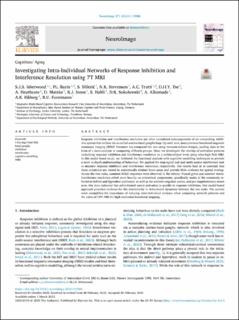| dc.contributor.author | Isherwood, S.J.S. | |
| dc.contributor.author | Bazin, PL. | |
| dc.contributor.author | Miletić, S. | |
| dc.contributor.author | Stevenson, N.R. | |
| dc.contributor.author | Trutti, A.C. | |
| dc.contributor.author | Tse, Desmond H. Y. | |
| dc.contributor.author | Heathcote, A. | |
| dc.contributor.author | Matzke, D. | |
| dc.contributor.author | Innes, R.J. | |
| dc.contributor.author | Habli, Sarah | |
| dc.contributor.author | Sokołowski, Daniel | |
| dc.contributor.author | Alkemade, A. | |
| dc.contributor.author | Håberg, Asta | |
| dc.contributor.author | Forstmann, B.U. | |
| dc.date.accessioned | 2023-09-11T07:10:47Z | |
| dc.date.available | 2023-09-11T07:10:47Z | |
| dc.date.created | 2023-04-20T08:43:48Z | |
| dc.date.issued | 2023 | |
| dc.identifier.citation | NeuroImage. 2023, 271 . | en_US |
| dc.identifier.issn | 1053-8119 | |
| dc.identifier.uri | https://hdl.handle.net/11250/3088544 | |
| dc.description.abstract | Response inhibition and interference resolution are often considered subcomponents of an overarching inhibition system that utilizes the so-called cortico-basal-ganglia loop. Up until now, most previous functional magnetic resonance imaging (fMRI) literature has compared the two using between-subject designs, pooling data in the form of a meta-analysis or comparing different groups. Here, we investigate the overlap of activation patterns underlying response inhibition and interference resolution on a within-subject level, using ultra-high field MRI. In this model-based study, we furthered the functional analysis with cognitive modelling techniques to provide a more in-depth understanding of behaviour. We applied the stop-signal task and multi-source interference task to measure response inhibition and interference resolution, respectively. Our results lead us to conclude that these constructs are rooted in anatomically distinct brain areas and provide little evidence for spatial overlap. Across the two tasks, common BOLD responses were observed in the inferior frontal gyrus and anterior insula. Interference resolution relied more heavily on subcortical components, specifically nodes of the commonly referred to indirect and hyperdirect pathways, as well as the anterior cingulate cortex, and pre-supplementary motor area. Our data indicated that orbitofrontal cortex activation is specific to response inhibition. Our model-based approach provided evidence for the dissimilarity in behavioural dynamics between the two tasks. The current work exemplifies the importance of reducing inter-individual variance when comparing network patterns and the value of UHF-MRI for high resolution functional mapping. | en_US |
| dc.language.iso | eng | en_US |
| dc.publisher | Elsevier | en_US |
| dc.rights | Navngivelse 4.0 Internasjonal | * |
| dc.rights.uri | http://creativecommons.org/licenses/by/4.0/deed.no | * |
| dc.title | Investigating Intra-Individual Networks of Response Inhibition and Interference Resolution using 7T MRI | en_US |
| dc.title.alternative | Investigating Intra-Individual Networks of Response Inhibition and Interference Resolution using 7T MRI | en_US |
| dc.type | Peer reviewed | en_US |
| dc.type | Journal article | en_US |
| dc.description.version | publishedVersion | en_US |
| dc.source.pagenumber | 0 | en_US |
| dc.source.volume | 271 | en_US |
| dc.source.journal | NeuroImage | en_US |
| dc.identifier.doi | 10.1016/j.neuroimage.2023.119988 | |
| dc.identifier.cristin | 2141986 | |
| cristin.ispublished | true | |
| cristin.fulltext | original | |
| cristin.qualitycode | 2 | |

